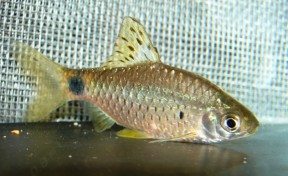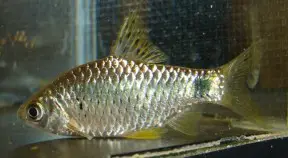Pethia punctata
SynonymsTop ↑
Puntius punctatus Day, 1865
Etymology
Pethia: the generic vernacular name for small cyprinids in the Sinhala language.
punctata: from the Latin punctatus, meaning ‘punctuated, dotted’.
Classification
Order: Cypriniformes Family: Cyprinidae
Distribution
Described from ‘Cochin, India’ which corresponds to the city of Kochi in Ernakulam district, Kerala state, southwestern India and endemic to the Western Ghats mountain range where it appears to be restricted to west flowing river systems.
Records exist from Wyanad and Ernakulam districts in Kerala plus the Indira Gandhi Wildlife Sanctuary and west flowing rivers in Kanyakumari district, Tamil Nadu state.
It may also occur in the Netravathi and Kumaradhara river drainages in Karnataka state.
Habitat
Apparently most abundant in shallow streams and minor tributaries, sometimes at relatively high altitudes, and apparently shows a preference for substrates of mud or silt.
Given the extent of its range it would seem sensible to assume that it inhabits various habitat-types which also vary in water depth, flow, and turbidity depending on the time of year.
Maximum Standard Length
50 – 55 mm.
Aquarium SizeTop ↑
Base dimensions of at least 75 ∗ 30 cm or equivalent are required.
Maintenance
Choice of décor is not especially critical though it tends to show better colouration in a heavily-planted set-up with a dark substrate.
The addition of some floating plants and driftwood roots or branches to diffuse the light entering the tank also seems to be appreciated and adds a more natural feel.
Filtration does not need to be particularly strong though it does seem to appreciate a degree of water movement and will also do well in a hill stream-type set-up.
Water Conditions
Temperature: 21 – 26 °C
pH: 6.0 – 7.5
Hardness: 36 – 215 ppm
Diet
Likely to be a foraging omnivore feeding on worms, insects and other small invertebrates, as well as plant material and organic detritus.
In the aquarium it’s easily-fed but the best condition and colours offer regular meals of small live and frozen foods such as bloodworm, Daphnia, and Artemia, alongside good quality dried flakes and granules, at least some of which should include additional plant or algal content.
Behaviour and CompatibilityTop ↑
Generally very peaceful making it an ideal resident of the well-researched community aquarium.
Fishes inhabiting similar biotopes in nature, especially comparably-sized, open water-dwelling cyprinids perhaps constitute the best choices but other potential options include balitorid, cobitid, and nemacheilid loaches as well as benthic cyprinids such as Crossocheilus and Garra species.
Try to buy a mixed-sex group of at least 8-10 specimens, include other schooling fishes to provide security, and you’ll be rewarded with a more natural-looking spectacle.
The interaction between rival males is interesting to watch and they will display their best colours when competing for female attention or hierarchical position.
Sexual Dimorphism
Adult males are noticeably slimmer and more colourful than females, especially in the unpaired and ventral fins.
Reproduction
Possibly unrecorded but recommendations for related species are as follows:
Like most small cyprinids Pethia spp. are egg-scattering free spawners exhibiting no parental care.
When in good condition they will spawn often and in a mature aquarium it’s possible that small numbers of fry may start to appear without intervention.
However if you want to maximise yield a more controlled approach is required.
The adult group can still be conditioned together but a smaller aquarium should also be set up and filled with mature water.
This should be very dimly lit and the base covered with some kind of mesh of a large enough grade so that the eggs can fall through but small enough so that the adults cannot reach them. The widely available plastic ‘grass’-type matting can also be used and works well, as does a layer of glass marbles.
Alternatively filling much of the tank with a fine-leaved plant such as Taxiphyllum spp. or spawning mops can also return decent results.
The water itself should be of slightly acidic to neutral pH with a temperature towards the upper end of the range suggested above, and an air-powered sponge filter or air stone(s) should also be included to provide oxygenation and water movement.
When the adults are well-conditioned and the females appear gravid one or two pairs should then be introduced, and spawning should take place the following morning.
An alternative is to spawn the fish in a group with half a dozen specimens of each sex being a good number, although a larger aquarium may be necessary.
In either situation the adults will probably eat the eggs given the chance and should be removed as soon as any are noticed.
These should hatch in 24 – 48 hours with the fry free swimming around 24 hours later.
They should be fed on an infusoria-grade food for the first few days until large enough to accept microworm, Artemia nauplii, or suchlike.
NotesTop ↑
This species is poorly-known in the aquarium hobby and has a confusing taxonomic history having been considered both synonymous with or a subspecies of the congener P. ticto in the past.
It can be distinguished from other members of the genus by the following combination of characters: lateral line complete with 27 scales (following Day, 1865) or 23-24 scales (following Knight et al., 2012); body with two dark blotches; anterior spot one scale row below lateral line; dorsal-fin with rows of spots.
It was formerly included in the Puntius conchonius ‘group’ of closely-related species alongside P. ater, P. bandula, P. conchonius, P. cumingii, P. didi, P. erythromycter, P. gelius, P. khugae, P. macrogramma, P. manipurensis, P. meingangbii, P. nankyweensis, P. nigripinnis, P. nigrofasciatus, P. padamya, P. phutunio, P. punctatus, P. reval, P. shalynius, P. thelys, P. tiantian, and P. ticto, but all of these were moved to the new genus Pethia by Pethiyagoda et al. (2012), as were P. melanomaculata, P. pookodensis, P. muvattupuzhaensis, P. ornatus, and P. yuensis.
‘Puntius‘ narayani was not moved to the new genus and is currently of uncertain generic placement since it uniquely possesses 9 branched dorsal-fin rays and 6 branched anal-fin rays.
Pethia species are defined by the following combination of characters: rostral barbels absent; maxillary barbels minute or absent; possession of a stiff, serrated last unbranched dorsal-fin ray; presence of a black blotch on the caudal peduncle, and frequently, black blotches, spots or bars on the side of the body; infraorbital 3 deep and partially overlapping the preoperculum.
The genus Puntius was viewed as a polyphyletic catch-all containing over 100 species of small to mid-sized cyprinid for a number of years until Pethiyagoda et al. (2012) published a partial review covering South Asian members.
The majority of sub-Himalayan Puntius species were reclassified and new genera Dawkinsia, Dravidia, and Pethia erected to accomodate some of them, with the remainder either retained in Puntius or moved to the existing Systomus assemblage, though the definition of the latter was altered meaning some Southeast Asian species formerly placed there are no longer members.
It subsequently became clear that the name Dravidia was preoccupied by a genus of flesh fly, therefore the replacement name Haludaria was made available by Pethiyagoda (2013).
No species from Indochina, China, or Indonesia were included in the study meaning a significant number of former Puntius are currently classed as incertae sedis, i.e., of uncertain taxonomic placement, and this also applies to a number of South Asian species of unresolved status.
They’re perhaps best referred to as ‘Puntius‘ for the time being whereby the genus name is surrounded by quotation marks to denote its questionable usage, and that is the convention used here on SF at the moment.
References
- Day, F., 1865 - Proceedings of the Zoological Society of London 1865 (pt 1): 286-318
On the fishes of Cochin, on the Malabar Coast of India. Part II. Anacanthini. - Knight, J. D. M., K. Rema Devi, T. J. Indra and M. Arunachalam, 2012 - Journal of Threatened Taxa 4(3): 2409-2416
A new species of barb Puntius nigripinnis (Teleostei: Cyprinidae) from southern Western Ghats, India. - Linthoingambi, I. and W. Vishwanath, 2007 - Zootaxa 1450: 45-56
Two new fish species of the genus Puntius Hamilton (Cyprinidae) from Manipur, India, with notes on P. ticto (Hamilton) and P. stoliczkanus (Day). - Mercy, T. V. A. and E. Jacob, 2007 - Journal of the Bombay Natural History Society 104(1): 76-78
A new species of Teleostei: Puntius pookodensis (Cyprinidae) from Wayanad, Kerala, India. - Pethiyagoda, R., 2013 - Zootaxa 3646(2): 199
Haludaria, a replacement generic name for Dravidia (Teleostei: Cyprinidae). - Pethiyagoda, R., M. Meegaskumbura, and K. Maduwage, 2012 - Ichthyological Exploration of Freshwaters 23(1): 69-95
A synopsis of the South Asian fishes referred to Puntius (Pisces: Cyprinidae).



